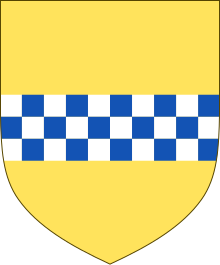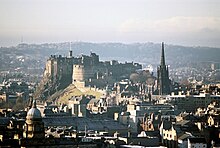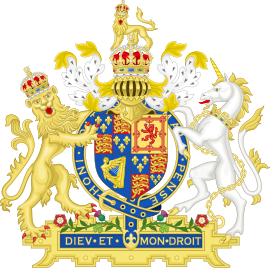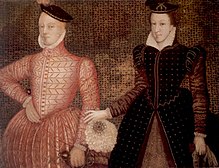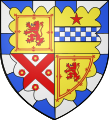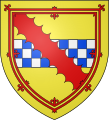Stewart House
The House of Stewart (also Clan Stewart ) is a Scottish noble family . The main line of the family was the kings of Scotland from 1371 to 1587 . Thereafter, the Scottish crown fell through marriage to a branch line of the same house, which was called the House of Stuart and from 1603 also provided the kings of England and Ireland in personal union. The royal House of Stuart was replaced on the British throne by the House of Hanover in 1714 and died out in the male line in 1807. Older sidelines and bastard lines still exist today.
history
The Stewarts came from the Breton family FitzAlan , who came from the city of Dol-de-Bretagne . The feudal sovereign there was the bishop of Dol . He used a court official with the title of Dapifer or Seneschal for the secular administration of his lands . The first recordable ancestor of the Stewart family was Alain, who was Dapifer of the Bishop of Dol in 1086. His grandson Alan Fitz Flaad went to the court of King Henry I of England, from whom he received various lands, including Oswestry in Shropshire .
Of Alan's three sons, the eldest, Jordan fitz Alan, returned to Brittany, the second, William fitz Alan, became Sheriff of Shropshire in 1137 and is the progenitor of the Earls of Arundel . The third son, Walter fitz Alan, went to Scotland around 1136. There he became Dapifer of King David I around 1150. He received lands in Renfrewshire and founded Paisley Abbey in 1163 . Around 1157 he was confirmed the hereditary position of his court office. His grandson Walter chose the more respected name Senescallus for his office from around 1219 . He established the family's good relations with the Bruce of Annandale family . Walter's son, Alexander of Dundonald , belonged to King Alexander III when he was a minor . from 1255 to 1261 as the Guardian of Scotland on the Regency Council. Above all, he was not only referred to as the king's steward , but also as the steward of Scotland , which enhanced his position. His younger brother Walter was the first family member to bear the name Stewart , although he never held the office himself.
James the Stewart , the eldest son of Alexander of Dundonald, was born after the death of Alexander III. Elected one of the six Guardians of Scotland in 1286. Although he never played a leading role, he was a driving force in the struggle for independence against England . In 1306 he supported Robert Bruce when he rose as Robert I to the rank of King of Scotland. James' son Walter Stewart commanded the left wing at the Battle of Bannockburn and thus contributed significantly to the victory over the English. He married Marjorie, the eldest daughter of Robert I. After the childless death of David II. In 1371, the son of Robert I, the crown fell to Walter's son Robert according to the inheritance regulation adopted in 1318. As the grandson of Robert I, Robert II became the first Stewart to be the Scottish King. His grandson Jacob I fought down the local nobility, murdered z. T. his rivals by hand and rearranged the country. With Jacob V , the main line of the Stewarts, i.e. the descendant line of Roberts II, died out in the male line in 1542. Only eight Stewart Kings lived to be older than 50, and only five of the family's seventeen rulers died of natural causes.
The line was continued by his daughter Maria Stuart (and her husband Henry Stuart, Lord Darnley , who came from an older branch of the family, as well as her half-brother James Stewart, 1st Earl of Moray ), who as the wife of the French King Francis II Stewart's name changed to the French spelling Stuart .
Maria Stuart's son, Jakob VI., After the death of Elizabeth I in 1603 as Jakob I, also became King of England . His son Charles I was defeated by parliamentary troops in the English Civil War and was beheaded at the instigation of Oliver Cromwell in 1649 after a high treason trial.

In the course of the Stuart Restoration in 1660, his son Charles II returned from exile, but in 1688 his brother and successor, Jacob II , who had converted to Catholicism, was overthrown in the Glorious Revolution and lived in exile in France until 1701. His two Protestant daughters from his first marriage, Maria II and Anne , ruled until 1694 and 1714, respectively, before the English Parliament legally established Protestant succession in the Act of Settlement (1701), bypassing the two Catholic children of Jacob II from his second marriage and with it a cousin from the House of Hanover , Elector Georg Ludwig, when Georg I appointed the throne. An attempt at restoration by the deposed king in Ireland in 1689/90 as well as attempts to overthrow his son James Francis Edward Stuart, who emigrated to Rome, and an invasion of the grandson Charles Edward Stuart (better known as Bonnie Prince Charlie ) in Scotland in 1708, 1715 and 1745/46 remained unsuccessful. With Charlie's brother Henry Benedict Stuart , the Cardinal of York, the exiled royal house of Stuart died out in the main male line in 1807. The Jacobites' claim to the throne then fell to the descendants of a sister of Jacob II from the House of Savoy and later to the House of Wittelsbach via the House of Habsburg-Lothringen . Via Elisabeth Stuart , the daughter of Jacob I and ancestor of the House of Hanover , who married a Protestant Wittelsbacher, all British monarchs who have ruled since then also descend from the Stuarts in a female line.
Heads of the House of Stewart and Stuart
High Stewards of Scotland
- Walter FitzAlan the Steward , 1st High Steward of Scotland (around 1110, † 1177)
- Alan fitz Walter, 2nd High Steward of Scotland (* around 1150; † 1204)
- Walter Fitzalan, 3rd High Steward of Scotland (* around 1198; † 1241)
- Alexander of Dundonald, 4th High Steward of Scotland (* around 1220, † 1282)
- James Stewart, 5th High Steward of Scotland (* around 1243; † 1309)
- Walter Stewart, 6th High Steward of Scotland (* 1292; † 1327)
- Robert Stewart, 7th High Steward of Scotland (* 1316 - † 1390) (1371 as Robert II King of Scotland)
Scottish monarchs
- Robert II (1371-1390)
- Robert III (1390-1406)
- Jacob I (James I) (1406–1437)
- James II (James II) (1437-1460)
- Jacob III (James III) (1460-1488)
- Jacob IV (James IV) (1488–1513)
- Jacob V (James V) (1513–1542)
- Maria Stuart (1542–1587)
- Jacob VI (James VI.) (1567-1625)
Scottish-English monarchs

- James I of England and VI. of Scotland (1603-1625)
- Charles I (1625–1649)
- Charles II (1660–1685)
- James II. Of England and VII. Of Scotland (1685- 1688 )
- Maria II. (1689–1694) ⚭ Wilhelm III. of England and II of Scotland
- Anne (1702–1714) (British monarch from 1707)
Jacobite pretenders

- James II. Of England and VII. Of Scotland ( 1688 -1701)
- Jacob III of England and VIII of Scotland (1701–1766)
- Charles III (1766–1788)
- Henry IX. of England and I of Scotland (1788–1807), Cardinal of York , last Stuart
- Charles IV (1807–1819) from the House of Savoy
- Viktor I. (1819-1824)
- Maria II (1824-1840)
- Franz I (1840–1875), Duke of Modena from the House of Habsburg-Lothringen
- Maria III, Queen of Bavaria (1875-1919)
- Rupprecht, Crown Prince of Bavaria (1919–1955) from the House of Wittelsbach
- Albrecht of Bavaria (1905–1996) (1955–1996)
- Franz von Bayern (since 1996)
Stewart branch lines
Dukes of Albany
Duke of Albany was a hereditary title of nobility of the Peerage of Scotland , which was awarded six times between 1398 and 1660 to younger sons of the Scottish royal family Stuart (the seventh and final award went to a member of the House of Saxe-Coburg and Gotha ).
Stewart of Darnley
The Stewart of Darnley family is a steward line of the House of Stewart founded by John Stewart of Bonkyl , a younger son of 4th High Steward Alexander Stewart. The name is derived from the Barony Derneley in Renfrewshire, which was given to Sir John Stewart in 1356.
John of Derneley, who died in the Battle of the Herring in 1429 , married Isabel, daughter of Duncan, 8th Earl of Lennox , in 1392 . In 1488, his grandson John Stewart, Lord Darnley, was appointed 1st Earl of Lennox.
Matthew Stewart, 4th Earl of Lennox, married Margaret Douglas , niece of King Henry VIII, bringing his descendants close to the English throne. His son Henry Stewart, Lord Darnley married the Scottish Queen Maria Stuart and in both son James I , who also inherited the English throne, the Darnley line reunited with the royal house of Stuart. A younger brother of the 4th Earl of Lennox became a French citizen and founded the line of Dukes of Lennox. The Darnley family used both the Stewart name and the French name Stuart.
Other lines of the House of Stuart and the Stewart clan
Alexander Stewart, 1st Earl of Buchan (approx. 1343-1394) was the fourth son of King Robert II ; he had six illegitimate sons with a lover. The Stewarts of Balquhidder , whose founder Sir William Stewart of Baldorran (approx. 1440 – approx. 1500) was a great-grandson of Murdoch Stewart, 2nd Duke of Albany , was also descended from King Robert II . They later split into the Stewarts of Ardvorlich, Glen Buckie, Gartnafuaran, and Annat. The branch, which is still located on Ardvorlich House (on Loch Earn ) today, is considered to be the main line of this branch, the current head of which is Alexander Stewart, 15th Laird of Ardvorlich .
Murdoch Stewart, 2nd Duke of Albany, also leads back to the line raised in 1800 in the Peerage of Ireland to Earls of Castle Stewart , which is represented today by Arthur Patrick Avondale Stuart, 8th Earl Castle Stewart (* 1928).
Some other Scottish subsidiary lines of the Stewart clan , in the old spelling, also exist to this day, but split off before the Scottish accession to the throne in 1371 and therefore do not descend from the ruling House of Stuart. The non-royal tribes were the since the 14th century in the Scottish Highlands - including on Castle Stalker - based Stewarts of Appin (now Chief is Andrew Francis Stewart of Lorn, 17th of Appin and 12th of Ardsheal ) and the Stewarts of Atholl the eighth award of the title Earl of Atholl (see below). As today's main line of the Stewart clan , the Earls of Galloway are considered to be descended from John Stewart of Bonkyl (* before 1269; † 1298). Its head is Randolph Stewart, 13th Earl of Galloway (* 1928).
James Stewart of Lorne , a descendant of Alexander Stewart, 4th High Steward of Scotland , had two sons, John , who was made Earl of Atholl in 1457 and James , Earl of Buchan from 1469, whose title fell to a female descendant in 1551; his illegitimate son James Stewart, 1st Laird of Traquair (1480-1513), he bequeathed Traquair House , where the line - Earls of Traquair since 1633 - flourished in the male line until 1861; as Catholic loyalists, they supported the exiled royal Stuarts.
Coat of arms of the Earls of Galloway
Earls of Atholl
The title of Earl of Atholl had been given several times to members of the House of Stewart. He was led by King Robert II of Scotland before his accession to the throne, his son Walter Stewart, 1st Earl of Atholl , David Stewart, 1st Duke of Rothesay and also Robert Stewart, 1st Duke of Albany .
The eighth award of the title fell to a branch line of the House of Stewart, which is descended from John Stewart of Bonkyl . His great-grandson Robert Stewart of Durisdeer († 1403) married the heiress of the Lairds of Lorne. His brother and heir John was appointed laird of the feudal barony of Lorne in 1407. His eldest son Robert married a daughter of Robert Stewart, 1st Duke of Albany. Both son John, 2nd Laird of Lorne, were murdered in 1463, his daughter and heiress Isabel brought Lorne to the House of Campbell . Robert's younger son Walter was the progenitor of the Lairds of Innermeath, who inherited John Stewart, 6th Earl of Atholl, and became Earls of Atholl in the ninth bestowal.
John's, Laird of Lorne, younger son was James, the Black Knight of Lorne , who married the Scottish ex-queen Joan Beaufort and is father of John Stewart, 1st Earl of Atholl . After the death of the 5th Earl in 1595, the title of a distant sideline was reassigned, but this also expired in 1625 with James Stewart, 2nd Earl of Atholl; the title then passed on to a nephew of the last earl, John Murray, Master of Tullibardine, whose descendants still carry the title Duke of Atholl , which was awarded to them in 1703 .
Bastard lines
Furthermore, some " bastard lines " of the royal Stuarts still exist today in the male line. One of the oldest hybrid lines descends from John Stewart , an illegitimate son of the Scottish King Robert II . His descendants held the inheritance of sheriff of Buteshire from the 16th century . James Stuart was promoted to Baronet Stuart of Bute in 1627 . His grandson James Stuart was elevated to Earl of Bute in the Peerage of Scotland in 1703. John Stuart, 3rd Earl of Bute, served under George III. as prime minister . Several of his numerous descendants were elected as members of the House of Commons or made careers in the military. Due to inheritances, numerous members added other names to the name Stuart. John Stuart, 4th Earl of Bute , was promoted to 1st Marquess of Bute in 1796. John Crichton-Stuart, 3rd Marquess of Bute, acquired the administrative office of the royal Falkland Palace in 1887 , which his descendants still exercise today. James Stuart-Wortley , a grandson of the 3rd Earl of Bute, was raised to Baron Wharncliffe in 1826 . His grandson Edward Montagu-Granville-Stuart-Wortley was made Earl of Wharncliffe in 1876.
Further bastard lines of the royal Stuarts are the descendants of the British King Charles II and raised to the rank of duke Lennox ( Duke of Richmond ), Scott ( Duke of Buccleuch ), FitzRoy ( Duke of Grafton ) and Beauclerk ( Duke of St. Albans ) as well the Catholic Fitz-James ( Duke of Berwick ), who descended from Charles II's brother and successor James II and who went into exile in France and later Spanish with him .
See also
literature
- Ronald G. Asch : The Stuarts. History of a dynasty . Munich 2011, ISBN 978-3-406-61189-6 .
- Steve Boardman: The First Stewart Dynasty: Scotland, 1371-1488. Edinburgh University Press, Edinburgh 2017, ISBN 978-0-7486-1235-2 .
- John Miller: The Stuarts . Hambledon & London, London 2004, ISBN 1-85285-432-4
Web links
- GWS Barrow: Stewart family (per. C. 1110 – c. 1350). In: Henry Colin Gray Matthew, Brian Harrison (Eds.): Oxford Dictionary of National Biography , from the earliest times to the year 2000 (ODNB). Oxford University Press, Oxford 2004, ISBN 0-19-861411-X , ( oxforddnb.com license required ), as of 2004
